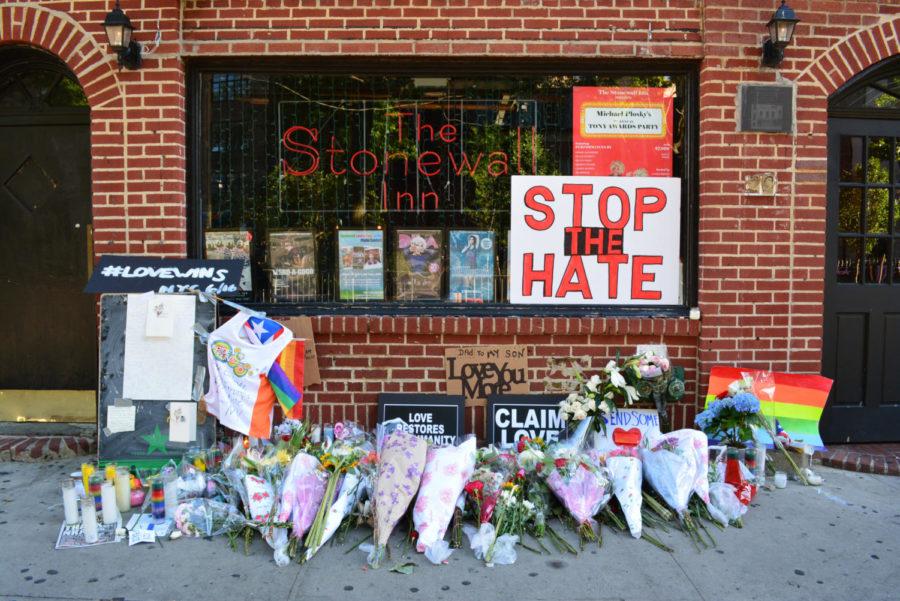“Looking at the most marginalized”: celebrating the 50th anniversary of Stonewall riots
New York, USA – June 12, 2017: Memorial outside the landmark Stonewall Inn in honor of the victims of the mass shooting at a gay nightclub in Orlando in New York City in 2016.
June 26, 2019
It was a hot summer morning in New York in 1969. Police raided a gay bar resulting in a riot, credited with beginning the gay rights movement continuing today.
The bar in question was The Stonewall Inn, and this year marks the 50th anniversary of the Stonewall riots.
Friday is also nearly four years to the day since the decision of Obergefell v. Hodges, which resulted in the legalization of same-sex marriage nationwide.
In the early morning of June 28, 1969 — armed with a warrant — police officers entered the club and roughed up patrons. They found unauthorized alcohol and arrested 13 people — including employees and people violating the state’s gender-appropriate clothing statute, under which female officers would take suspected cross-dressing patrons into the bathroom to check their sex, according to History.com.
Fed up with constant police harassment and social discrimination, angry patrons and neighborhood residents hung around outside the bar rather than disperse — becoming increasingly agitated as the events unfolded and people were aggressively manhandled.
“Stonewall was a fantastic uprising of the queer and trans community against police that were over policing them,” said nicci port, project director for diversity and inclusion and LGBTQIA+ initiatives.
The riots started when an officer hit a lesbian woman over the head as he forced her into the paddy wagon. She shouted to onlookers to act, inciting the crowd to begin to throw pennies, bottles, cobblestones and other objects at the police, according to History.com.
Within minutes, a full-blown riot involving hundreds of people began. The police, a few prisoners and a Village Voice writer barricaded themselves in the bar, which the mob attempted to set on fire after breaching the barricade repeatedly. Reinforcements were called in by the police, and for several hours they tried to clear the streets while the crowd fought back.
The fire department — and a riot squad — were eventually able to douse the flames and rescue those inside Stonewall. But the protests, sometimes involving several thousand people, continued in the area for five days.
Though the Stonewall uprising did not truly begin the gay rights movement, it was a galvanizing force that inspired queer people throughout the country to organize, and within two years of Stonewall, gay rights groups had been started in nearly every major city in the U.S., including the Gay Liberation Front, Human Rights Campaign, GLAAD (formerly Gay and Lesbian Alliance Against Defamation), and PFLAG (formerly Parents, Families and Friends of Lesbians and Gays).
The site of the uprisings in Greenwich Village is recognized as a National Historic Landmark (NHL) by the National Park Service. In 2016, President Barack Obama designated the bar, Christopher Park, and the streets where the events of June 28 to July 3, 1969 occurred as part of the NHL. The Stonewall Inn is located at 51-53 Christopher Street, Manhattan, New York and is open to the public.
“There is important distance yet to travel, but through political engagement and litigation — as well as individual acts of courage and acceptance — this movement has made tremendous progress toward securing equal rights and equal dignity,” Obama said during his proclamation creating the Stonewall National Monument.
The 1960s and preceding decades were typified by a hostile legal environment for LGBTQIA+ people. For instance, solicitation of homosexual relations was illegal in New York, and a criminal statute allowed police to arrest people wearing less than three gender-appropriate articles of clothing, according to History.com.
As a result, queer individuals flocked to gay bars and clubs, places of refuge where they could express themselves openly and socialize without worry. However, the New York State Liquor Authority penalized and shut down establishments that served alcohol to known — or suspected — LGBTQIA+ individuals, arguing the gathering of homosexuals was “disorderly.”
Resulting from activists’ efforts, these regulations were overturned in 1966, and LGBTQIA+ patrons could thereafter be served alcohol. But engaging in gay behavior in public such as: holding hands, kissing or dancing with someone of the same sex was still illegal — so police harassment of gay bars continued, and many bars still operated without liquor licenses.
“This was a time when our community came together to show solidarity,” port said. “I think it is a good example to look back on because so much of our LGBTQ community now has gotten used to not looking at the most marginalized of our community.”
















